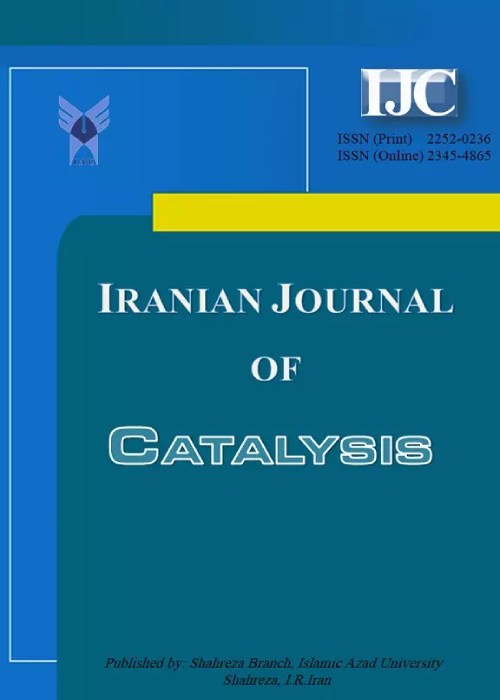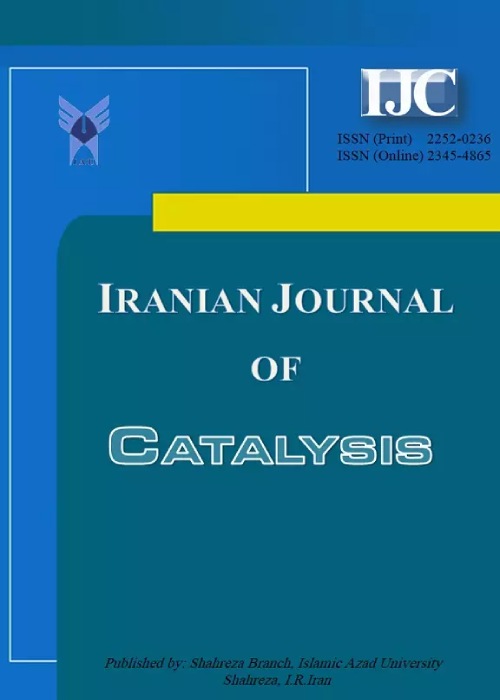فهرست مطالب

Iranian Journal of Catalysis
Volume:13 Issue: 3, Summer 2023
- تاریخ انتشار: 1402/06/10
- تعداد عناوین: 10
-
-
Pages 235-270
It's fascinating to see how much research has been done on ferrite nanoparticles over the past few years. These small magnetic particles have unique properties that allow them to be manipulated at a very small scale. This review article is focused on the preparation of ferrite magnetic nanoparticles and silica-coated ferrite nanoparticles using various functionalized compounds. Recently, it has been found that these nanoparticles can be used as nanocatalysts in a variety of reactions, including coupling and multicomponent reactions. They provide excellent and environmentally friendly yields, which is a great benefit. It's exciting to see how these tiny particles can have such a big impact on the world of science.
Keywords: Iron Oxide, Synthetic methods, Biodegradable, Recyclability, Synthesis -
Pages 271-284In this study, we synthesized ethyl levulinate (EL) by alcoholysis of furfuryl alcohol (FAL) with ethanol using two catalysts, SBA-15-SO3H (SHS-15) and SBA-16-SO3H (SHS-16). The catalysts were prepared through the hydrothermal method, and their physical and chemical properties were assessed using various techniques such as small and wide-angle XRD, N2-sorption, SEM, TEM, FTIR, and Py-FTIR. Characterization results showed that SHS-15 possesses a mesoporous structure with a higher surface area and uniform pore size, along with moderate Brønsted acidity. In catalytic activity, both catalysts were tested for converting FAL to EL under moderate reaction conditions. SHS-15 exhibited excellent performance, achieving a yield of 93.9% for ethyl levulinate at 110°C, with a 0.5g catalyst dose, 1g FAL, and 4h reaction time. In contrast, SHS-16 yielded 88.6%, which was lower than SHS-15. These findings highlight the potential of SHS-15 as an effective catalyst for the alcoholysis of FAL into EL under moderate reaction conditions.Keywords: Furfuryl alcohol, Ethyl levulinate, Ethyl alcohol, SHS-15, SHS-16
-
Pages 285-297Both metal oxides, ceria (CeO2) and stania (SnO2) are prepared by precipitation technique using ammonia solution (1:1) and characterized by thermogravimetric analysis (TGA), x-ray powder diffraction (XRD), transmission electron microscope (TEM), nitrogen adsorption-desorption (for the specific surface area determination, SBET) and used in the photodegradation of Tenoxicam (TEN) antibiotics by using ultraviolet irradiation in presence of hydrogen peroxide. The obtained results showed that ceria and stania have a comparable surface area of 12 and 11 m2 g-1, respectively, and the crystallite size measured by XRD was found to be 44 and 18 nm for ceria and stania, respectively. Also, the results show that by increasing the exposure time, the amount of degraded antibiotic was increased. Data obtained show that both oxides, ceria, and stania can be used effectively as catalysts in the photodegrading process as photocatalysts. Stania is faster than ceria to degrade TEN antibiotics. Ceria needs more time than stania to degrade the drug at 100%, in which the TEN is fully degraded in the presence of stania and H2O2 at 40 minutes under certain conditions.Keywords: Adsorption, Photocatalyst, Kinetics, Cerium Oxide, Tin Oxide
-
Pages 299-317In this research, a novel approach for the epoxidation of alkene derivatives was constructed. Based on this fact, the appropriate ligand was provided from the reaction of hydrazine hydrate and 5-methyl-1,3,4-thiadiazole-2-thiol. Then, after preparation of the intermediate compound, the treatment of the pointed compound and 4-hydroxy-3,5-dimethoxybenzaldehyde in the presence of a few drops of glacial acetic acid for 3h was done in order to a final ligand. Then, the synthesized ligand was metallated using Cr, Fe, Co, and Cu to obtain a series of organometallic catalysts. The synthesized organometallic catalysts were analyzed using CHNS analysis, FT-IR spectroscopy, and magnetic susceptibility. Then, the organometallic complexes containing (Chromium, Iron, Cobalt, and Copper) are applied in the epoxidation of various alkenes to provide corresponding target products and provide moderate to good yields. The prepared organometallic complexes were investigated relative to the reusability and loss of metal into the medium of the reaction. In addition, the optimized chemical structures of organometallic complexes were investigated using DFT calculation.Keywords: Epoxidation, Alkene, Organometallic, catalyst, Antimicrobial, DFT calculation
-
Pages 319-330The sol-gel technique is employed for the synthesis of tungsten trioxide (WO3) nanosheets. The Au/WO3 nanocomposite is prepared using laser ablation employing an Nd-YAG laser operating at a wavelength of 1064 nm and utilizing gold metal. The SEM images demonstrate that WO3 was formed as nanosheets with a thickness between 36nm and 80nm. X-ray diffraction (XRD) patterns confirmed the monoclinic crystal structure and high crystallinity of the WO3 structure. The optical absorption of both WO3 nanosheets and Au/WO3 nanocomposite exhibited a pronounced absorption edge, with an energy gap of 2.52 eV and 2.41 eV, respectively. The photocatalytic activity of WO3 nanosheets and Au/WO3 nanocomposite was determined by degrading Methylene blue (MB) dye under visible light irradiation using different catalyst doses and pH values. The WO3 nanosheets and Au/WO3 nanocomposites that were prepared demonstrate a fast degradation of MB dye. The highest photodegradation efficiency (PDE) of MB dye was 75.9% when 0.05 g of Au/WO3 nanocomposite was exposed to 7 pH for 6 min of irradiation. Nevertheless, an increase of pH led to a corresponding rise in PDE. Particularly, the PDE values reached 85.5% and 95.7% when using 0.1 g of WO3 nanosheets and Au/WO3 nanocomposite, respectively, under the conditions in a pH level of 12 and an irradiation duration of 6 minutes.Keywords: Au, WO3, Nanosheets, nanocomposite, Photodegradation, Methylene blue dye
-
Pages 331-340
Lanthanum (III) oxide (La2O3) was applied as an efficient bifunctional catalyst to develop a new methodology in the production of 2-amino-4-aryl-4H-pyrans and pyrazolopyranopyrimidines in the absence of solvent. In both synthetic protocol, due to the dual functionality of lanthanum (III) oxide (i.e. having basic and acidic Lewis sites), it was very useful and general, and plausible mechanisms were presented in support of this generality and high capability. The current protocol featured environmentally friendly conditions, the ability to recycle and reuse the heterogeneous catalyst up to 6 times, providing products in short times with high yields, easy work-up and no need for difficult steps of catalyst synthesis by using a commercially available catalyst, which makes it an appealing route for the preparation of these derivatives.
Keywords: Lanthanum(III) oxide, Dual-functional catalyst, 2-amino-4-aryl-4H-pyrans, Pyrazolopyranopyrimidines, Solvent-free conditions, One-pot, multi-component reaction -
Pages 341-358The synthetic dyes which are largely used in the textile industries pollute the total ecosystem. They can be treated using different technologies but in order to avoid secondary pollution and to carry out an eco-friendly technique, an electrocoagulation process has been adopted. In this work, two sets of electrodes which act as the electrocatalysts for the process of electrocoagulation, with one set containing aluminium as an anode and the other with copper as anode has been used to contrast and compare the removal efficacies. The colour removal efficiency was observed as 98.42% for Al-Cu, and 95.12% for Cu-Al electrodes. The COD and BOD removal efficiency was found to be 89.74%, 86.1% for Al-Cu and 87.15%, 85.23% for Cu-Al electrodes. The cost for the treatment process was 3.31 US$/m3 and 0.22 US$/m3 for Al-Cu and Cu-Al electrodes respectively. The sludge was subjected to EDX, SEM, and XPS analysis which showed the formation of hydroxides and dissolution of an anode implying copper as the best anode material. The energy and electrode consumption, operating cost was minimum for copper than aluminium. Due to high COD and BOD removal, the treated water can be reused for agriculture and for fish growth.Keywords: BOD, Catalytic activity, COD reduction, Dissimilar electrodes, Textile effluent
-
Pages 359-372A series of bismuth-silicate photocatalysts were synthesized via the sol-gel method for photodegradation of methylene blue (MB) under sunlight irradiation, utilizing rice husk ash as a silica precursor. The scanning electron microscopy/energy dispersive X-ray (SEM/EDX) analysis detected Bi content in 3-10 wt% range. Furthermore, it can be seen that the porosity decreased as the Bi concentration increased. The N2 adsorption-desorption analysis indicates the presence of mesopores with an average diameter of 297-554 Å with Brunauer–Emmett–Teller (BET) surface area of 5.6-30.5 m2/g. The photocatalyst with a Bi concentration of 4 wt% (RHSBi-A2) was the most active in the photodegradation of MB; the removal reached 90% within 4 h. The photodegradation is proposed to be driven by superoxide ( ), hydroxyl (•OH) radicals, and hole (h+) based on the valence band (VB) and conduction band (CB) potentials. The porous silica framework is proposed to act as an electron reservoir, allowing better MB adsorption and enhancing light absorption.Keywords: Bismuth, Mesoporous silica, Methylene Blue, Photocatalyst, Rice husk, Sunlight
-
Pages 373-378Zahra Alishahi was born in 1999 in Qom, Iran. She received her B.Sc. in applied chemistry (2021) from Qom University. She is currently working towards her M.Sc. under the supervision of Professor Mohammad Ali Zolfigol at Bu-Ali Sina University. Her research interest is the design, synthesis and catalytic applications of magnetic nanoparticles and porous organic polymers in organic transformations.Keywords: catalyst, Rotaxane, Asymmetric, Molecular machines
-
Pages 379-385Erfan Abdoli was born in Kermanshah, Iran in 1997, and has already accomplished impressive feats in his academic and research career. He completed his undergraduate studies in Medical Chemistry at Azad University in Kermanshah, Iran in 2021, and has since continued his education by pursuing a master’s degree in Organic Chemistry starting in 2022, with the esteemed Professor Mohammad Ali Zolfigol as his supervisor.Keywords: Porous organic polymers, CO2 fixation, POPs, Two-Dimensional, Heterogeneous catalysts


